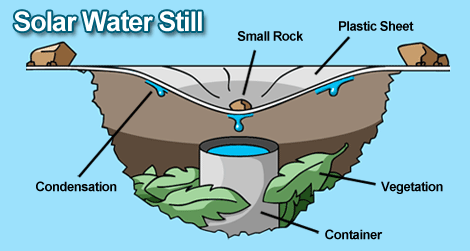Overview
This guide goes into details on storing and purifying water. This is meant to give you a tool to reason about how to prepare for and act in emergencies that disrupt your water supply.
Storing Water
How much to store?
- Ready.gov recommends storing 3 gallons of water per person to last for 3 days. A normally active person needs about ¾ gallons per day to drink and you can use the rest for cleaning. Needs vary with outside temp, humidity, exercise, and illness. Finan thinks you should store a two-week supply of water. Most scenarios won’t call for it, but water is probably the most essential thing you need. Wirecutter agrees the 3 day recommendation is unreasonably low (especially for people in earthquake country). Ultimately the decision of how much water to store comes down to your own estimation of risk, how prepared you want to be, and how much effort you want to invest in storing and maintaining your water supplies.
What do I store water in?
- One of these containers can hold enough water for one person (drinking and cleaning) for a week. Fill at least two for each person in your house and replace the water every 6 months (set yourself a calendar reminder)
- Generally it’s good to store water out of the sun so the plastic doesn’t degrade.
- If there were no contaminants, the water would be safe to drink indefinitely, it would have no shelf life. The 6 month recommendation is in case contamination happened while bottling and to avoid making the water taste like plastic.
- To minimize contamination, thoroughly wash your hands before filling storage containers, and while filling take care to avoid touching any part of the “inside” of the container or lid.
- It’s also reasonable to just buy and store bottled water if that feels easier.
- Bottled water has no official shelf life, but you want to store it out of the sun and after a while it will taste like plastic. Finan would replace stored bottled water after 2 years.
How else do I stay hydrated?
- Don’t exert yourself unnecessarily. Sweating will reduce your water and salt content.
- Don’t just drink water. You need electrolytes (salt, sugar) too.
- Eat food with some salt.
- It would be good to have some pedialyte or other electrolytes to help you re-hydrate.
- Avoid drinking a lot of alcohol or coffee (or other things with caffeine). Both can dehydrate you.
Purifying Water
Boiling
- Boiling is the most basic water purification. This will kill microorganisms, but won’t necessarily remove contaminants like heavy metals.
- In a pot on the stove bring your water to a rolling boil(bubbling actively) for at least one minute. The exact time is debated, but 1 minute seems the most widely accepted.
- It’ll boil faster if it has a lid. You’ll also lose less water to evaporation.
- Don’t boil water with a bunch of particulate matter in it and assume it’ll be fine. If the only water source you have has a lot of sludge, find some way to filter it first, even if that’s just putting it through a piece of cloth.
Chlorination
- Chlorination - Add 1/8 teaspoon of bleach (5.25-6%) per gallon of water, stir and let stand for 30 minutes. Chlorination also won’t remove contaminants like heavy metals.
Distillation
- This is collecting only the vapor from boiling water. This can be as simple as setting a cup under a slightly tilted oversized lid on a pot of boiling water (the cup should be under the drip point). But feel free to get creative with whatever is at hand. This will kill bacteria and viruses with heat and filter out heavy metals as they won’t evaporate with the water.
Water Purification Tablets
- There are a lot on the market. Most work similarly to bleach. Just follow the instructions for whichever you choose to buy.
- Water purification tablets should kill any bacteria and viruses, but won’t filter out anything like heavy metals or chemicals your water may have been contaminated with.
Pump or Gravity Filters
- There are a lot of water filters made for camping. You could buy one to be able to purify water from lakes and streams. Check the specific products to see how well they filter.
- Filters tend to filter out bacteria and reduce chemical contaminants, but not filter out viruses or heavy metals. Read the description when you buy. If they don’t explicitly tell you the filter gets rid of something, it probably doesn’t
Solar Still
- This is the same as distillation, just letting the sun (rather than the stove or fire boiling) do the work. All you need is a clear/ plastic sheet and a container to drip water into.
- Dig a hole smaller than the width of your plastic sheet.
- Put in green plants and unclean water so there is something to be evaporated.
- Put in your water vessel.
- Cover the hole with the plastic sheet. Pile dirt or something heavy along the edges to keep the sheet in place.
- Use a small rock to create an indentation in the sheet above your water vessel.
- Wait. The sun will evaporate the water. Then it will condense on the sheet and drip into your water vessel. It is then safe to drink.

